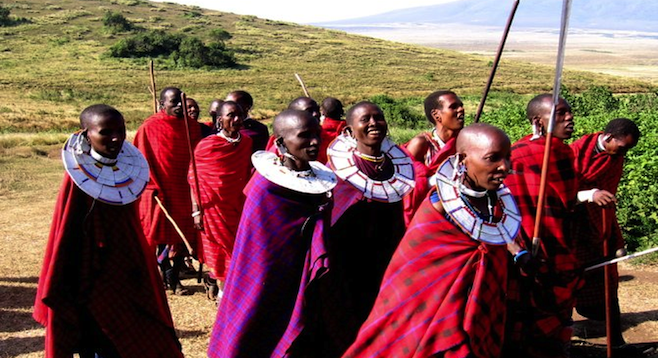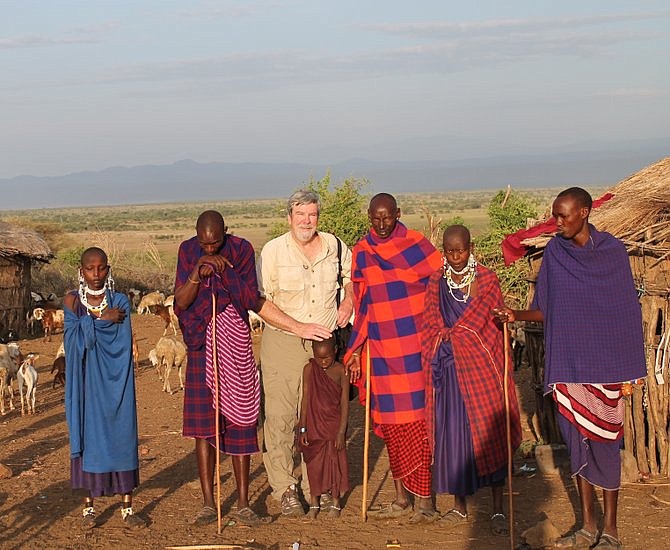 Facebook
Facebook
 X
X
 Instagram
Instagram
 TikTok
TikTok
 Youtube
Youtube

There are some images so iconic, they're forever associated with a particular place. Certainly among the foremost would be the Maasai and East Africa.
More than any other tribal culture, the Maasai embody both the spirit and symbolism of the land.
The Maasai are historically are a semi-nomadic, Nilotic ethnic group whose oral histories suggest their origin to be the southern Nile Valley.
By the mid-19th century their territory, expanding south, claimed the entire Rift Valley and they were the most feared warriors of the equatorial zone. Today, they range throughout southern Kenya and northern Tanzania, their half-million population a very questionable estimate as most Kenyan Maasai will not cooperate with a government-run census and Tanzania does not count people according to ethnicity. Getting an accurate count of nomads has always presented problems.
Even more than most ethnic groups, the Maasai cling to the old ways, resisting encroachment by the modern world. However, the past two decades have seen them more and more beginning to embrace a capitalist system. Many of them are gradually merging the old world with the new.
First and foremost, they are people of the earth, living in tight-knit circular villages known as bomas. These consist of huts, constructed by the women from mud and cow dung over a wood frame with wooden-fenced cattle kraals in the center, protecting them from predators. The boma is usually surrounded by a wall of acacia thorn bushes with a single opening that can be closed at will.
A flight over Maasai land will reveal a landscape dotted with circular bomas so numerous as to resemble craters on the moon.
As traditional nomads, they periodically abandon their bomas for better grazing lands for their cattle. Since the homes are organic, they are simply left to return to the land and a new village is constructed wherever they end up. Today, as more and more international organizations are helping to build schools and drill water wells, many Maasai are settling more permanently in areas to raise their families and cattle herds.

Generally speaking the Maasai are tall, thin, stately looking people who favor bright red or purple robes (shukas). Both men and women adorn themselves with intricate beaded jewelry including head bands, necklaces, bracelets, earrings, wrist cuffs and anklets, and – interestingly enough – prefer wearing sandals made from old truck tires. These square-toed shoes leave a track that makes it impossible for an enemy to decipher which direction the wearer is headed. They have no chiefs, but are ruled by counsels of elders who rise in rank and status with age and experience through a complex social system.
Tradition and ceremony rule daily life. Both boys and girls endure circumcision. For boys, who are divided by age groups, it is a preliminary step towards manhood and induction into the multiple levels of the warrior society. As for the girls, today many individual Maasai clans are performing the ceremony but eliminating the actual cutting, eliminating months of painful recovery. One interesting point of note is that boys still have two front teeth removed early on. This tradition goes back to ancient days when lockjaw was a problem in the bush, and the removal of teeth allowed small amounts of food and drink to be ingested.
While the Maasai gave up their warring ways generations ago, choosing to live in peace with all neighbors, they still maintain a warrior mentality. Men carry either a spear or a stout walking stick, and most wear a lethal bush knife on their belt, even when in modern cities.
Though it is now forbidden by law, in days gone by a young Maasai boy had to participate in a lion hunt with a spear and shield before being accepted as a man. Today, while tending to their cattle herds, a Maasai will not hesitate to take on a lion with his ever-present spear.
After their children, cattle are central to the Maasai way of life. A complex cosmology directly links cattle to their all-encompassing deity, Enkai (Engai), from whom they believe all the cattle on earth emanated and were meant exclusively for the Maasai. Like most cultures with no written language (Maa is the spoken word), their oral history includes an intricate creation legend.
The Maasai are people for whom time has little meaning; they live in the moment. For outsiders like myself dealing with the tribe, this can be an irritating trait, but it must be remembered that it's a cultural nuance and never meant to be off-putting.
They do not believe in an afterlife, but that at death, you simply cease to exist and return to the earth. Because of this and the mindset that a rotting body contaminates the earth, they do not bury their dead, but leave them out to be claimed by predators. Sometimes, though, exceptions are made to this rule – such as in the case of revered elders who are buried as a sign of respect, so that animals will not desecrate their bodies.
In recent years the Maasai have come under increasing government pressure to assimilate into modern society, but for the most part have resisted these efforts. Their traditional grazing lands have slowly been turned into national game parks, and this combination of a fascinating culture along with countless wild animals is a driving force behind tourism throughout East Africa today.
The modern Maasai still live the old way but welcome the new world to visit them. They are a warm and friendly people, eager to show their culture to outsiders, and a visit to any one of their villages is a necessary part of your trip to East Africa.


There are some images so iconic, they're forever associated with a particular place. Certainly among the foremost would be the Maasai and East Africa.
More than any other tribal culture, the Maasai embody both the spirit and symbolism of the land.
The Maasai are historically are a semi-nomadic, Nilotic ethnic group whose oral histories suggest their origin to be the southern Nile Valley.
By the mid-19th century their territory, expanding south, claimed the entire Rift Valley and they were the most feared warriors of the equatorial zone. Today, they range throughout southern Kenya and northern Tanzania, their half-million population a very questionable estimate as most Kenyan Maasai will not cooperate with a government-run census and Tanzania does not count people according to ethnicity. Getting an accurate count of nomads has always presented problems.
Even more than most ethnic groups, the Maasai cling to the old ways, resisting encroachment by the modern world. However, the past two decades have seen them more and more beginning to embrace a capitalist system. Many of them are gradually merging the old world with the new.
First and foremost, they are people of the earth, living in tight-knit circular villages known as bomas. These consist of huts, constructed by the women from mud and cow dung over a wood frame with wooden-fenced cattle kraals in the center, protecting them from predators. The boma is usually surrounded by a wall of acacia thorn bushes with a single opening that can be closed at will.
A flight over Maasai land will reveal a landscape dotted with circular bomas so numerous as to resemble craters on the moon.
As traditional nomads, they periodically abandon their bomas for better grazing lands for their cattle. Since the homes are organic, they are simply left to return to the land and a new village is constructed wherever they end up. Today, as more and more international organizations are helping to build schools and drill water wells, many Maasai are settling more permanently in areas to raise their families and cattle herds.

Generally speaking the Maasai are tall, thin, stately looking people who favor bright red or purple robes (shukas). Both men and women adorn themselves with intricate beaded jewelry including head bands, necklaces, bracelets, earrings, wrist cuffs and anklets, and – interestingly enough – prefer wearing sandals made from old truck tires. These square-toed shoes leave a track that makes it impossible for an enemy to decipher which direction the wearer is headed. They have no chiefs, but are ruled by counsels of elders who rise in rank and status with age and experience through a complex social system.
Tradition and ceremony rule daily life. Both boys and girls endure circumcision. For boys, who are divided by age groups, it is a preliminary step towards manhood and induction into the multiple levels of the warrior society. As for the girls, today many individual Maasai clans are performing the ceremony but eliminating the actual cutting, eliminating months of painful recovery. One interesting point of note is that boys still have two front teeth removed early on. This tradition goes back to ancient days when lockjaw was a problem in the bush, and the removal of teeth allowed small amounts of food and drink to be ingested.
While the Maasai gave up their warring ways generations ago, choosing to live in peace with all neighbors, they still maintain a warrior mentality. Men carry either a spear or a stout walking stick, and most wear a lethal bush knife on their belt, even when in modern cities.
Though it is now forbidden by law, in days gone by a young Maasai boy had to participate in a lion hunt with a spear and shield before being accepted as a man. Today, while tending to their cattle herds, a Maasai will not hesitate to take on a lion with his ever-present spear.
After their children, cattle are central to the Maasai way of life. A complex cosmology directly links cattle to their all-encompassing deity, Enkai (Engai), from whom they believe all the cattle on earth emanated and were meant exclusively for the Maasai. Like most cultures with no written language (Maa is the spoken word), their oral history includes an intricate creation legend.
The Maasai are people for whom time has little meaning; they live in the moment. For outsiders like myself dealing with the tribe, this can be an irritating trait, but it must be remembered that it's a cultural nuance and never meant to be off-putting.
They do not believe in an afterlife, but that at death, you simply cease to exist and return to the earth. Because of this and the mindset that a rotting body contaminates the earth, they do not bury their dead, but leave them out to be claimed by predators. Sometimes, though, exceptions are made to this rule – such as in the case of revered elders who are buried as a sign of respect, so that animals will not desecrate their bodies.
In recent years the Maasai have come under increasing government pressure to assimilate into modern society, but for the most part have resisted these efforts. Their traditional grazing lands have slowly been turned into national game parks, and this combination of a fascinating culture along with countless wild animals is a driving force behind tourism throughout East Africa today.
The modern Maasai still live the old way but welcome the new world to visit them. They are a warm and friendly people, eager to show their culture to outsiders, and a visit to any one of their villages is a necessary part of your trip to East Africa.
Comments